Changes in Selected Water Quality Parameters in the Utrata River as a Function of Catchment Area Land Use
Abstract
:1. Introduction
2. Materials and Methods
2.1. Description of the Field Campaign
- Samples 1–10 came from grasslands,
- Samples 10–15 from urbanised areas and
- Samples 16–24 from agricultural areas (Figure 2).
2.2. Methods
- Water quality class I—very good ecological status
- Water quality class II—good ecological status.
2.3. Weather Conditions
3. Results
4. Discussion
5. Conclusions
Author Contributions
Funding
Institutional Review Board Statement
Informed Consent Statement
Data Availability Statement
Conflicts of Interest
References
- Paule-Mercado, M.; Lee, B.; Memon, S.; Umer, S.; Salim, I.; Lee, C.-H. Influence of land development on stormwater runoff from a mixed land use and land cover catchment. Sci. Total. Environ. 2017, 599, 2142–2155. [Google Scholar] [CrossRef] [PubMed]
- Yahya, A.S.A.; Ahmed, A.N.; Othman, F.B.; Ibrahim, R.K.; Afan, H.A.; El-Shafie, A.; Fai, C.M.; Hossain, S.; Ehteram, M.; Elshafie, A. Water quality prediction model based support vector machine model for ungauged river catchment under dual scenarios. Water 2019, 11, 1231. [Google Scholar] [CrossRef] [Green Version]
- Cavalcante, H.; Cruz, P.S.; Viana, L.G.; Silva, D.d.L.; Barbosa, J.E.d.L. Influence of the use and the land cover of the catchment in the water quality of the semiarid tropical reservoirs. J. Hyperspectr. Remote Sens. 2017, 7, 389–398, ISSN:2237-2202. [Google Scholar] [CrossRef] [Green Version]
- Shi, P.; Zhang, Y.; Li, Z.; Li, P.; Xu, G. Influence of land use and land cover patterns on seasonal water quality at multi-spatial scales. Catena 2017, 151, 182–190. [Google Scholar] [CrossRef]
- Peruzzi, C.; Galli, A.; Chiaradia, E.A.; Masseroni, D. Evaluating longitudinal dispersion of scalars in rural channels of agro-urban envi-ronments. Environ. Fluid Mech. 2021, 21, 925–954. [Google Scholar] [CrossRef]
- Rodrigues, V.; Estrany, J.; Ran-zini, M.; de Cicco, V.; Tarjuelo Martín-Benito, J.M.; Hedo, J.; Lucas-Borja, M.E. Effects of land use and seasonality on stream water quality in a small tropical catchment: The headwater of Córrego Água Limpa, São Paulo (Brazil). Sci. Total Environ. 2018, 622, 1553–1561. [Google Scholar] [CrossRef] [PubMed] [Green Version]
- Bartnicki, J. Atmospheric contribution to eutrophication of the Baltic Sea. In Air Pollution Modeling and its Application XXVI; Springer: Cham, Switzerland, 2018; pp. 53–57. [Google Scholar]
- Rattan, K.; Corriveau, J.; Brua, R.; Culp, J.; Yates, A.; Chambers, P. Quantifying seasonal variation in total phosphorus and nitrogen from prairie streams in the Red River Basin, Manitoba Canada. Sci. Total. Environ. 2017, 575, 649–659. [Google Scholar] [CrossRef]
- Shi, P.; Zhang, Y.; Song, J.; Li, P.; Wang, Y.; Zhang, X.; Li, Z.; Bi, Z.; Zhang, X.; Qin, Y.; et al. Response of nitrogen pollution in surface water to land use and social-economic factors in the Weihe River watershed, northwest China. Sustain. Cities Soc. 2019, 50, 101658. [Google Scholar] [CrossRef]
- Schmadel, N.M.; Harvey, J.W.; Alexander, R.B.; Schwarz, G.E.; Moore, R.B.; Eng, K.; Gomez-Velez, J.; Boyer, E.; Scott, D. Thresholds of lake and reservoir connectivity in river networks control nitrogen removal. Nat. Commun. 2018, 9, 2779. [Google Scholar] [CrossRef] [Green Version]
- Abed, S.A.; Ewaid, S.; Al-Ansari, N. Evaluation of water quality in the Tigris River within Baghdad, Iraq using multivariate statistical techniques. J. Phys. Conf. Ser. 2019, 1294, 072025. [Google Scholar] [CrossRef]
- Li, C.; Liu, Q.; Lei, G.; Wu, B. The NH_4^+ -N Pollution in the Liuxi River and the Correlations Analysis of NH_4^+ -N and TN, COD, DO. Int. Core J. Eng. 2020, 6, 64–68. [Google Scholar] [CrossRef]
- Arif, M.; Kumar, R.; Parveen, S.; Verma, N. Reduction in water pollution in Yamuna River due to lockdown under COVID-19 pandemic. Pharma Innov. J. 2020, 9, 84–89. [Google Scholar]
- Csábrági, A.; Molnár, S.; Tanos, P.; Kovács, J.; Molnár, M.; Szabó, I.; Hatvani, I.G. Estimation of dissolved oxygen in riverine ecosystems: Comparison of differently optimized neural networks. Ecol. Eng. 2019, 138, 298–309. [Google Scholar] [CrossRef]
- Rout, C. Assessment of water quality: A case study of river Yamuna. Int. J. Earth Sci. Eng. 2017, 10, 398–403. [Google Scholar] [CrossRef]
- Jarvie, H.P.; Neal, C.; Withers, P.J. Sewage-effluent phosphorus: A greater risk to river eutrophication than agricultural phosphorus? Sci. Total. Environ. 2006, 360, 246–253. [Google Scholar] [CrossRef] [PubMed]
- Hilton, J.; O′Hare, M.; Bowes, M.; Jones, J.I. How green is my river? A new paradigm of eutrophication in rivers. Sci. Total. Environ. 2006, 365, 66–83. [Google Scholar] [CrossRef]
- Wojtkowska, M. Wpływ sposobu zagospodarowania zlewni na poziom zanieczyszczenia rzeki Utraty. Gaz Woda Tech. Sanit. 2006, 11, 70–72. [Google Scholar]
- Rydałowski, M.; Jurczuk, S.; Łempicka, A. Charakterystyka sprzętu i organizacji użytkowania środków ochrony roślin w gospodarstwach na terenie Utraty. Water Environ. Rural Areas 2008, 8, 63–79. [Google Scholar]
- Google Maps. Available online: https://www.google.com/maps/@52.0870381,20.6425979,43960m/data=!3m1!1e3 (accessed on 30 September 2021).
- PN EN 25813: Water Quality—Determination of Dissolved Oxygen—Iodometric Method; Polish Committee for Standardization: Warsaw, Poland, 1997.
- PN EN ISO 8467: Water Quality–Determination of Permanganate Index; Polish Committee for Standardization: Warsaw, Poland, 2001.
- PN EN ISO 6878: Water Quality—Determination of Phosphorus—Ammonium Molybdate Spectrometric Method; Polish Committee for Standardization: Warsaw, Poland, 2006.
- PN-EN ISO 11732: Water Quality—Determination of Ammonium Nitrogen by Flow Analysis (CFA and FIA) and Spectrometric Detection; Polish Committee for Standardization: Warsaw, Poland, 2007.
- Stackpoole, S.M.; Stets, E.G.; Sprague, L.A. Variable impacts of contemporary versus legacy agricultural phosphorus on US river water quality. Proc. Natl. Acad. Sci. USA 2019, 116, 20562–20567. [Google Scholar] [CrossRef] [Green Version]
- Hu, Y.; Long, C.M.; Wang, Y.-C.; Kerkez, B.; Scavia, D. Urban total phosphorus loads to the St. Clair-Detroit River System. J. Great Lakes Res. 2019, 45, 1142–1149. [Google Scholar] [CrossRef]
- Dey, G.; Banerjee, P.; Sharma, R.K.; Maity, J.P.; Etesami, H.; Shaw, A.K.; Huang, Y.-H.; Huang, H.-B.; Chen, C.-Y. Management of phosphorus in salinity-stressed agriculture for sustainable crop production by salt-tolerant phosphate-solubilizing bacteria—A review. Agronomy 2021, 11, 1552. [Google Scholar] [CrossRef]
- Pistocchi, C.; Tamburini, F.; Gruau, G.; Ferhi, A.; Trevisan, D. Tracing the sources and cycling of phosphorus in river sediments using oxygen isotopes: Methodological adaptations and first results from a case study in France. Water Res. 2017, 111, 346–356. [Google Scholar] [CrossRef] [PubMed] [Green Version]
- Podedworna, J. Ocena efektu ekologicznego modernizacji i rozbudowy oczyszczalni ścieków dla potrzeb analizy porealizacyjnej—Zagadnienia metodyczne i studium przypadku oddziaływania ścieków oczyszczonych na jakość wód odbiornika. Gaz Woda Tech. Sanit. 2017, 1, 25–30. [Google Scholar] [CrossRef]
- Burzyńska, I. Evaluation of selected physical and chemical indicators in Raszynka River. Woda Środowisko Obszary Wiejskie 2016, 16, 23–34. [Google Scholar]
- Ji, W.; Xiao, J.; Toor, G.S.; Li, Z. Nitrate-nitrogen transport in streamwater and groundwater in a loess covered region: Sources, drivers, and spatiotemporal variation. Sci. Total. Environ. 2021, 761, 143278. [Google Scholar] [CrossRef]
- Yi, Q.; Chen, Q.; Hu, L.; Shi, W. Tracking nitrogen sources, transformation, and transport at a basin scale with complex plain river networks. Environ. Sci. Technol. 2017, 51, 5396–5403. [Google Scholar] [CrossRef]
- Dolgov, S.V.; Koronkevich, N.I. Biogenic runoff from the Nizhny Novgorod area. Water Resour. 2019, 46, S94–S100. [Google Scholar] [CrossRef]
- Tang, J. Dynamic linkages between vegetation phenology and seasonal changes in water quality in the Choptank watershed, USA. Int. J. Remote. Sens. 2015, 36, 3041–3057. [Google Scholar] [CrossRef]
- De Girolamo, A.M.; Balestrini, R.; D′Ambrosio, E.; Pappagallo, G.; Soana, E.; Porto, A.L. Antropogenic input of nitrogen and riverine export from a Mediterranean catchment. The Celone, a temporary river case study. Agric. Water Manag. 2017, 187, 190–199. [Google Scholar] [CrossRef]
- Malagó, A.; Bouraoui, F.; Vigiak, O.; Grizzetti, B.; Pastori, M. Modelling water and nutrient fluxes in the Danube River basin with SWAT. Sci. Total. Environ. 2017, 603, 196–218. [Google Scholar] [CrossRef] [PubMed]
- Hu, Y.; Lu, Y.; Liu, C.; Shang, P.; Liu, J.; Zheng, C. Sources and dynamics of dissolved inorganic carbon, nitrogen, and phosphorus in a large agricultural river basin in Arid Northwestern China. Water 2017, 9, 415. [Google Scholar] [CrossRef] [Green Version]
- Ağca, N.; Doğan, K. Assessment of ammonium, nitrate and phosphorus pollution in the Asi River. In Proceedings of the 1st International Congress on Biosystems Engineering (ICOBEN 2019), Antakya, Turkey, 24–27 September 2019. [Google Scholar]
- Kadriu, S.; Sadiku, M.; Kelmendi, M.; Shala, A. The impact of polluting sources on the physical-chemical properties of water in the Curved River in Kosovo. J. Environ. Treat. Tech. 2020, 9, 368–374. [Google Scholar] [CrossRef]
- Borysiewicz, A.; Bonisławska, M.; Czerniejewski, P.; Kierasiński, B. Quality analysis of waters from selected small water courses within the river basins of Odra River and Wisła River. Rocznik Ochrona Środowiska 2019, 21, 1202–1216. [Google Scholar]
- Lin, J.; Chen, N.; Wang, F.; Huang, Z.; Zhang, X.; Liu, L. Urbanization increased river nitrogen export to western Taiwan Strait despite increased retention by nitrification and denitrification. Ecol. Indic. 2020, 109, 105756. [Google Scholar] [CrossRef]
- Null, S.E.; Mouzon, N.R.; Elmore, L.R. Dissolved oxygen, stream temperature, and fish habitat response to environmental water purchases. J. Environ. Manag. 2017, 197, 559–570. [Google Scholar] [CrossRef] [PubMed]
- Hosseini, N.; Johnston, J.; Lindenschmidt, K.-E. Impacts of climate change on the water quality of a regulated Prairie River. Water 2017, 9, 199. [Google Scholar] [CrossRef] [Green Version]
- Huang, J.; Yin, H.; Chapra, S.C.; Zhou, Q. Modelling dissolved oxygen depression in an Urban River in China. Water 2017, 9, 520. [Google Scholar] [CrossRef] [Green Version]
- Yaseen, Z.M.; Ehteram, M.; Sharafati, A.; Shahid, S.; Al-Ansari, N.; El-Shafie, A. The integration of nature-inspired algorithms with least square support vector regression models: Application to modeling river dissolved oxygen concentration. Water 2018, 10, 1124. [Google Scholar] [CrossRef] [Green Version]
- Mena-Rivera, L.; Salgado-Silva, V.; Benavides-Benavides, C.; Coto-Campos, J.M.; Swinscoe, T.H.A. Spatial and seasonal surface water quality assessment in a tropical urban catchment: Burío River, Costa Rica. Water 2017, 9, 558. [Google Scholar] [CrossRef] [Green Version]
- Basheer, A.O.; Hanafiah, M.M.; Abdulhasan, M.J. A study on water quality from Langat River, Selangor. Acta Sci. Malays. 2017, 1, 1–4. [Google Scholar] [CrossRef]
- Ahmed, A.M. Prediction of dissolved oxygen in Surma River by biochemical oxygen demand and chemical oxygen demand using the artificial neural networks (ANNs). J. King Saud. Univ. Eng. Sci. 2017, 29, 151–158. [Google Scholar] [CrossRef] [Green Version]
- Grzywna, A. The change of quantity and quality outflow of water in Ochożanka River basin. J. Water Land Dev. 2017, 35, 57–62. [Google Scholar] [CrossRef]
- Sokolov, D.; Erina, O.; Tereshina, M.; Chalov, S. Human impact on organic matter distribution in the Moskva River. In E3S Web of Conferences; EDP Sciences: Les Ulis, France, 2020; Volume 163, p. 05013. [Google Scholar]
- Arifi, K.; Tahri, L.; El Abid, A.; Hafiane, F.Z.; Elblidi, S.; Yahyaoui, A.; Fekhaoui, M. Impact of wastewater from the rural commune of Jmaa Moulblad on the physico-chemical quality of the waters of the Grou River (Rabat region, Morocco). In E3S Web of Conferences; EDP Sciences: Les Ulis, France, 2018; Volume 37, p. 01008. [Google Scholar]
- Duca, G.; Mereuta, A.; Velisco, N.; Tanaselia, C.; Mitina, T. Determination of quality indicators of Prut River water. Chem. J. Mold. 2019, 14, 61–67. [Google Scholar] [CrossRef]
- Zhu, L.; Song, J.; Liu, W. Using CSLD method to calculate COD pollution load of Wei River watershed above Huaxian Section, China. In IOP Conference Series: Earth and Environmental Science; IOP Publishing: Bristol, UK, 2017; Volume 100, p. 12016. [Google Scholar]
- Mirsaeedghazi, H. Effect of trout farm on the water quality of river using Iran water quality index (IRQWI): A case study on Deinachal River. J. Food Bioprocess Eng. 2018, 1, 13–20. [Google Scholar]
- Wu, Y.; Lin, H.; Yin, W.; Shao, S.; Lv, S.; Hu, Y. Water quality and microbial community changes in an Urban River after micro-nano bubble technology in situ treatment. Water 2019, 11, 66. [Google Scholar] [CrossRef] [Green Version]
- Nguyen, G.T. Evaluating current water quality monitoring system on Hau River, Mekong Delta, Vietnam using multivariate statistical techniques. Appl. Environ. Res. 2020, 42, 14–25. [Google Scholar] [CrossRef]
- Burzyńska, I. Monitoring of selected fertilizer nutrients in surface waters and soils of agricultural land in the river valley in Central Poland. J. Water Land Dev. 2019, 43, 41–48. [Google Scholar] [CrossRef] [Green Version]
- Kumar, B.; Singh, U.K.; Ojha, S.N. Evaluation of geochemical data of Yamuna River using WQI and multivariate statistical analyses: A case study. Int. J. River Basin Manag. 2019, 17, 143–155. [Google Scholar] [CrossRef]
- Uddin, N.; Jamil, N.A.H.M.; Reza, S. Seasonal variations and assessment of oxygen demanding parameters (DO, BOD, COD) in Solmari River, Bangladesh. Int. J. Eng. Sci. IJES 2017, 6, 45–48. [Google Scholar] [CrossRef]
- Mishra, B.K.; Regmi, R.K.; Masago, Y.; Fukushi, K.; Kumar, P.; Saraswat, C. Assessment of Bagmati river pollution in Kathmandu Valley: Scenario-based modeling and analysis for sustainable urban development. Sustain. Water Qual. Ecol. 2017, 9, 67–77. [Google Scholar] [CrossRef]
- Pang, Y.; Xiang, S.; Chu, Z.-S.; Xue, L.-Q.; Ye, B.-B. Relationship between agricultural land and water quality of Inflow River in Erhai Lake basin. Huan Jing Ke Xue Huanjing Kexue 2015, 36, 4005–4012. [Google Scholar] [PubMed]
- Ahearn, D.S.; Sheibley, R.W.; Dahlgren, R.A.; Anderson, M.; Johnson, J.; Tate, K.W. Land use and land cover influence on water quality in the last free-flowing river draining the western Sierra Nevada, California. J. Hydrol. 2005, 313, 234–247. [Google Scholar] [CrossRef]
- Namugize, J.N.; Jewitt, G.; Graham, M. Effects of land use and land cover changes on water quality in the uMngeni river catchment, South Africa. Phys. Chem. Earth Parts A B C 2018, 105, 247–264. [Google Scholar] [CrossRef]
- Wojtkowska, M.; Bojanowski, D. Influence of catchment use on the degree of river water pollution by forms of phosphorus. Rocznik Ochrona Środowiska 2018, 20, 887–904. [Google Scholar]
- Zhang, W.; Jin, X.; Zhu, X.; Meng, X.; Zhu, Y.; Zhang, C.; Tang, W.; Shan, B. Do NH 3 and chemical oxygen demand induce continuous release of phosphorus from sediment in heavily polluted rivers? Ecol. Eng. 2017, 102, 24–30. [Google Scholar] [CrossRef]
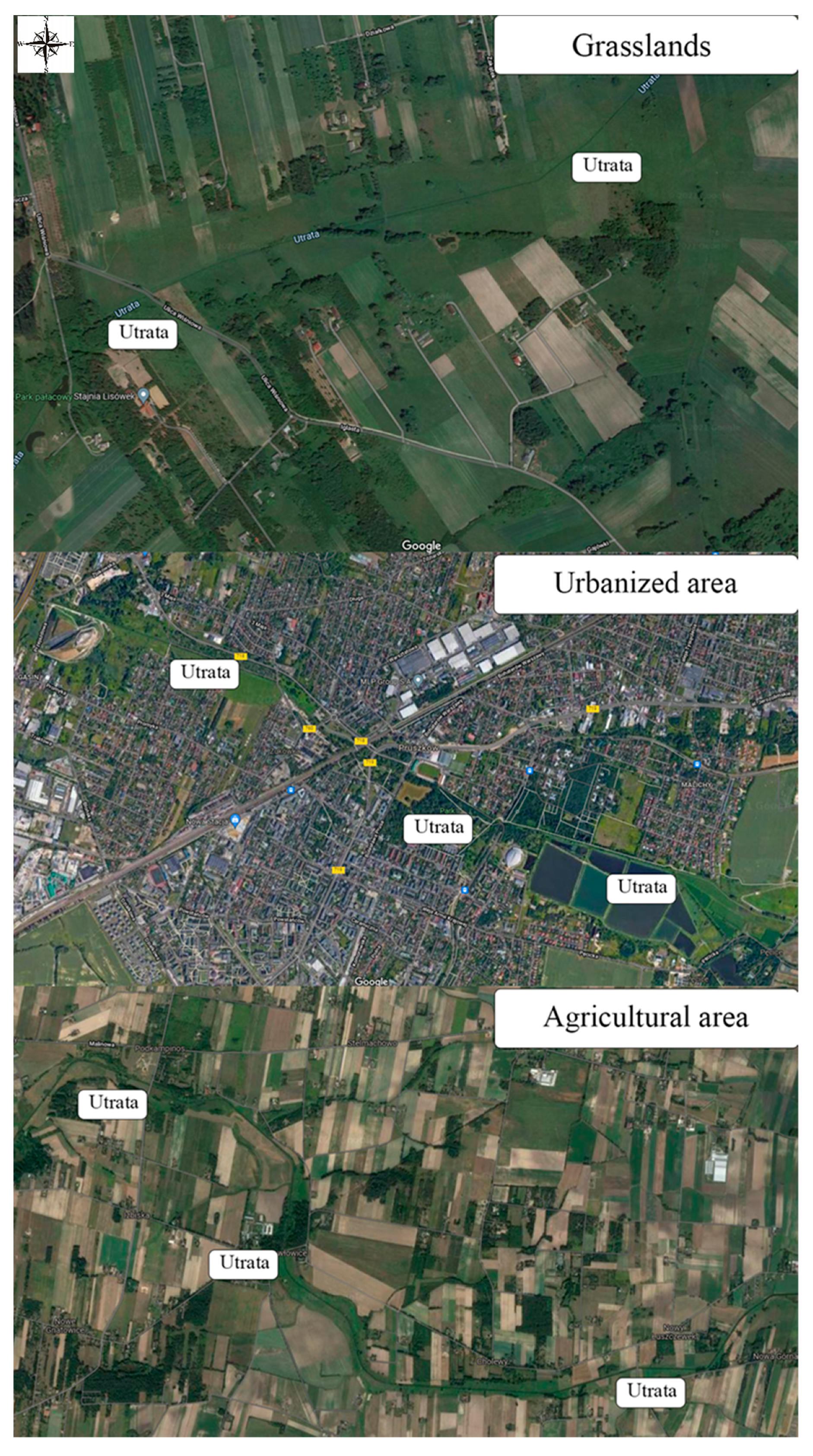
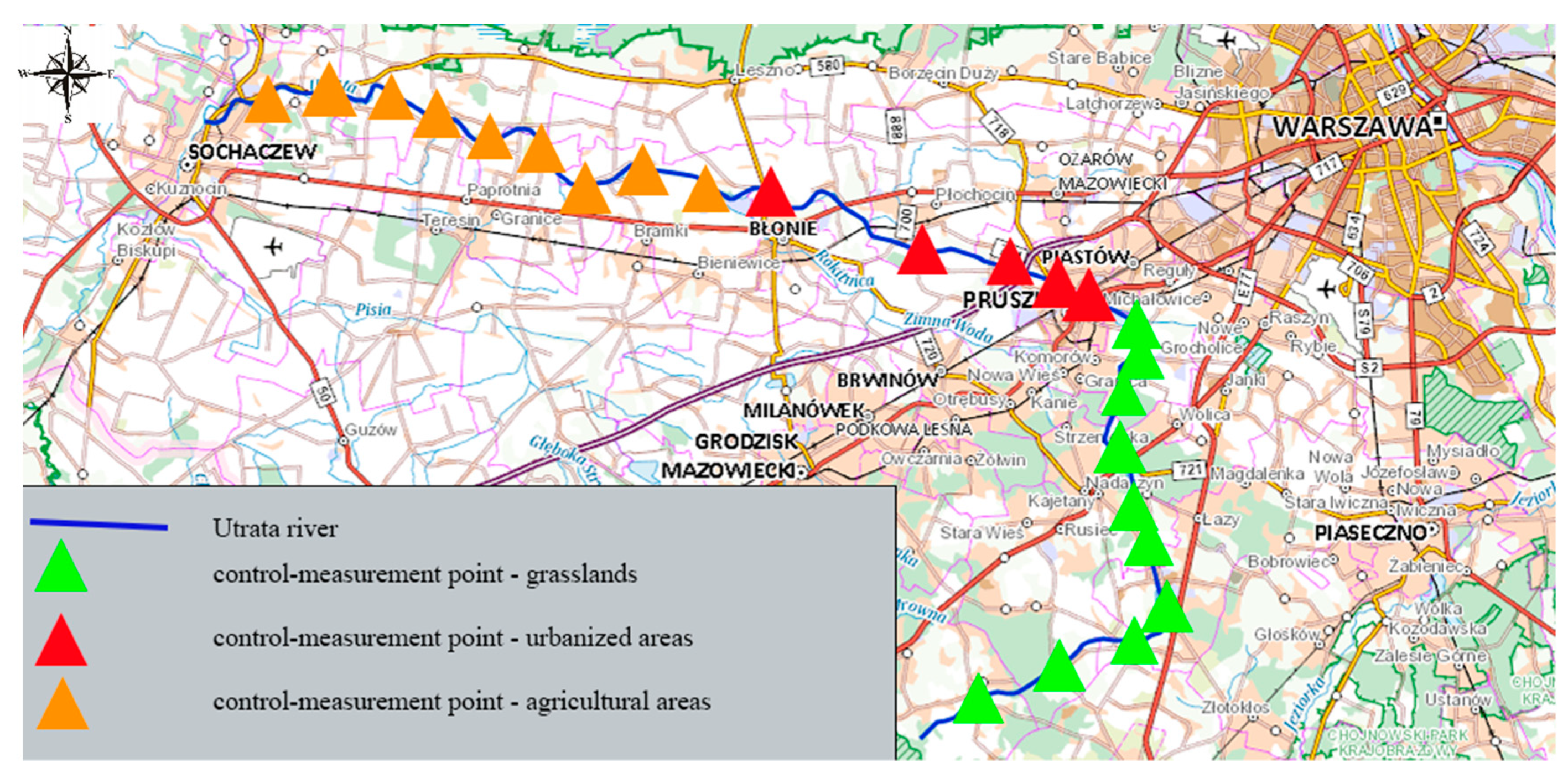
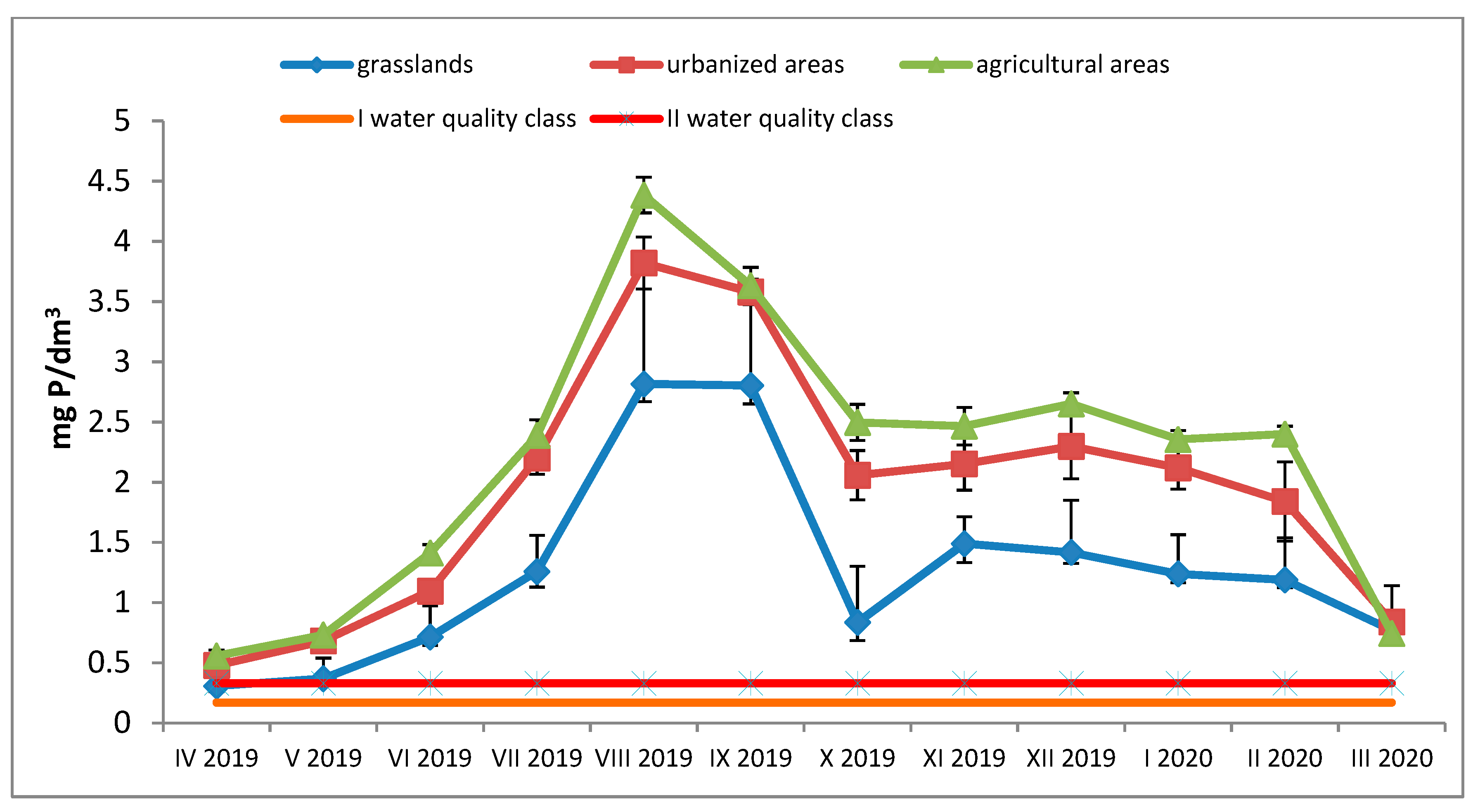
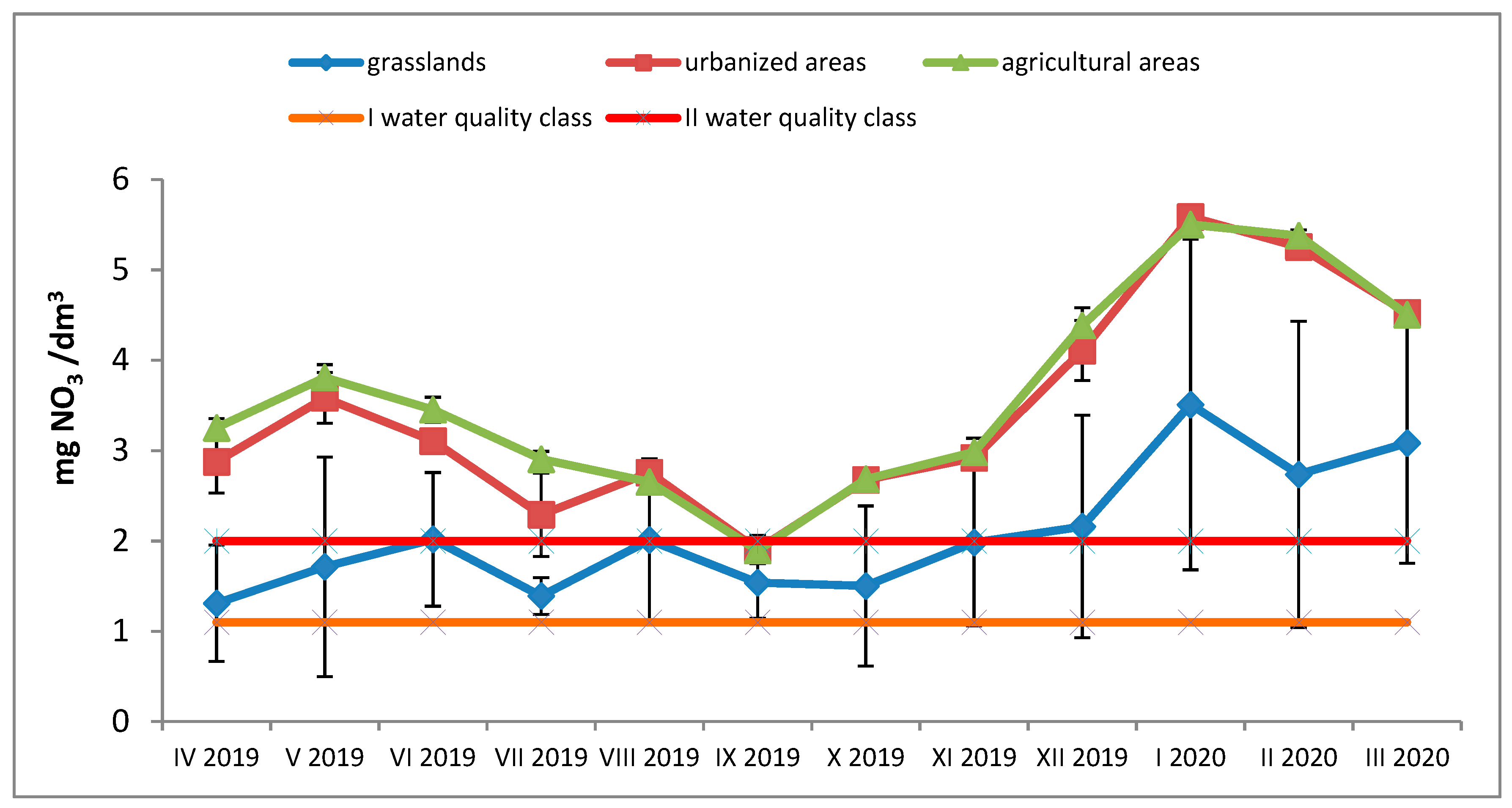
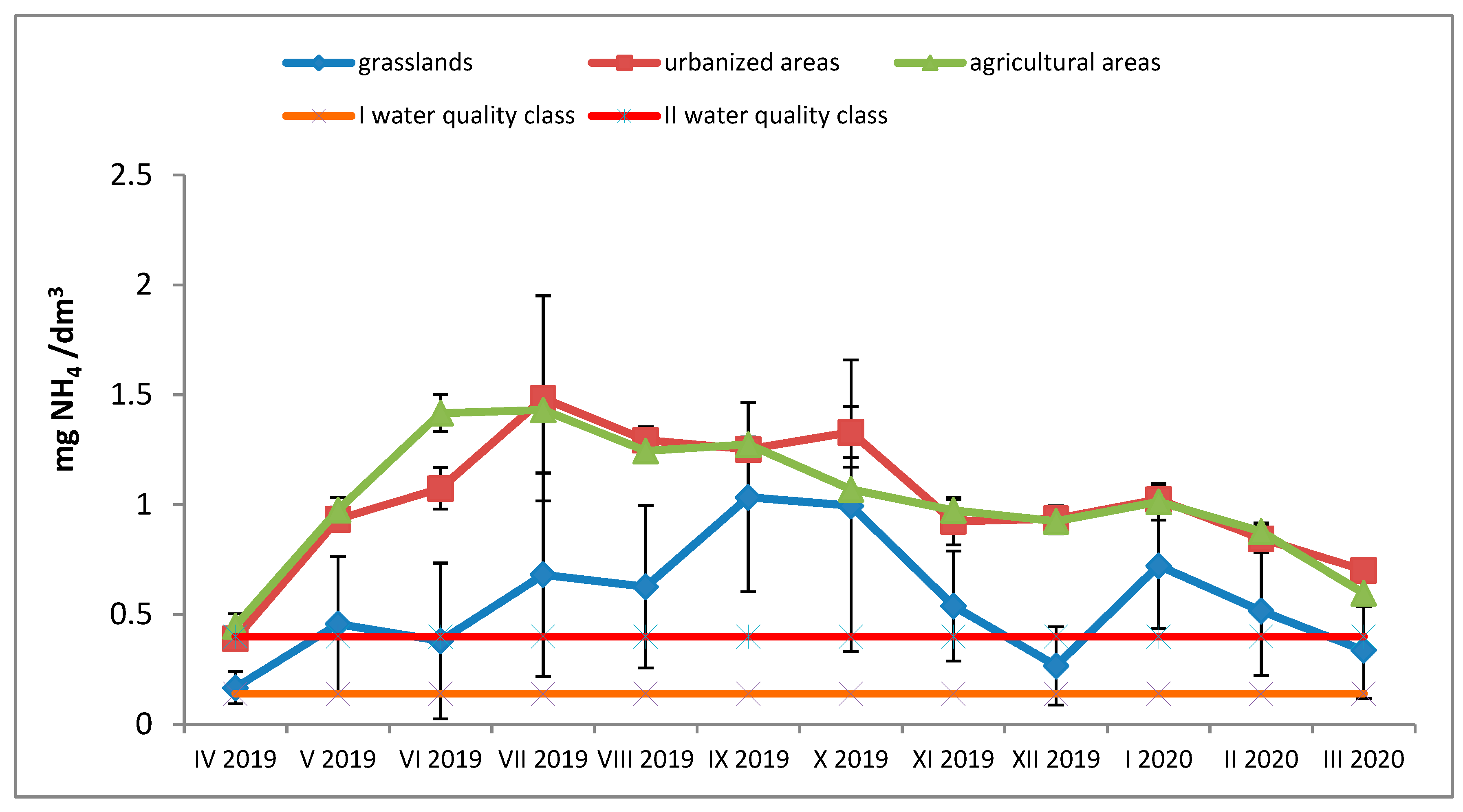

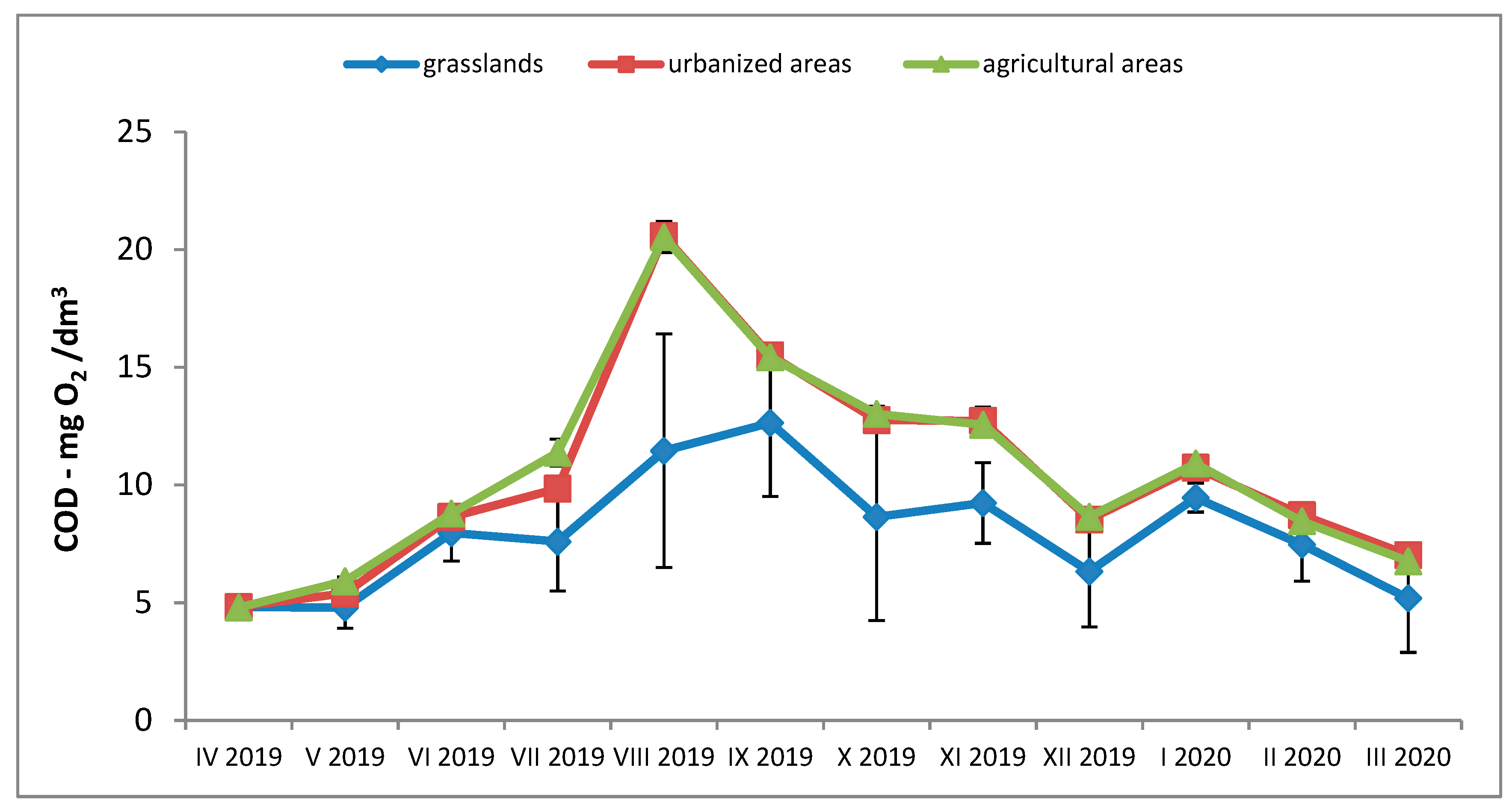
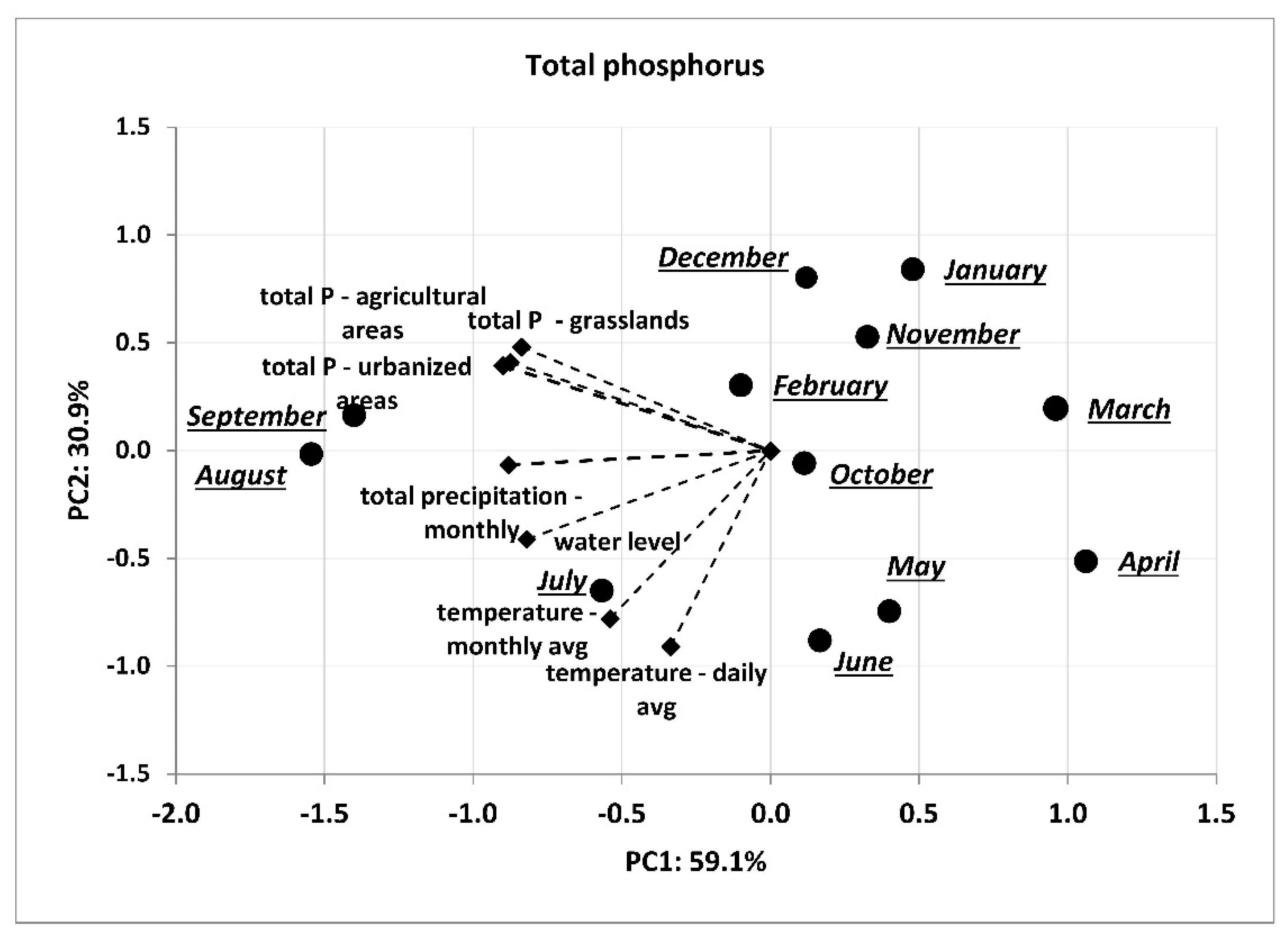
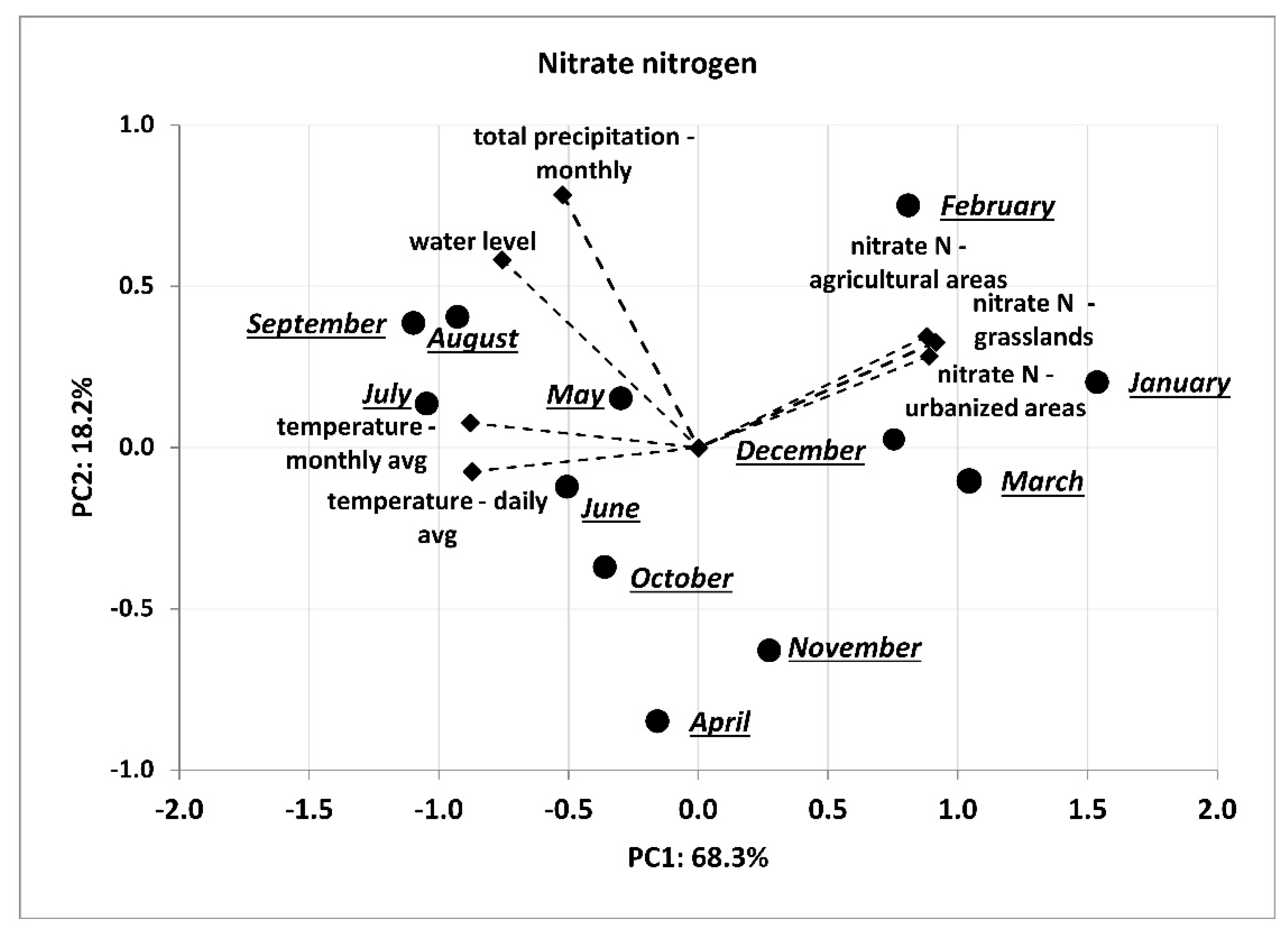
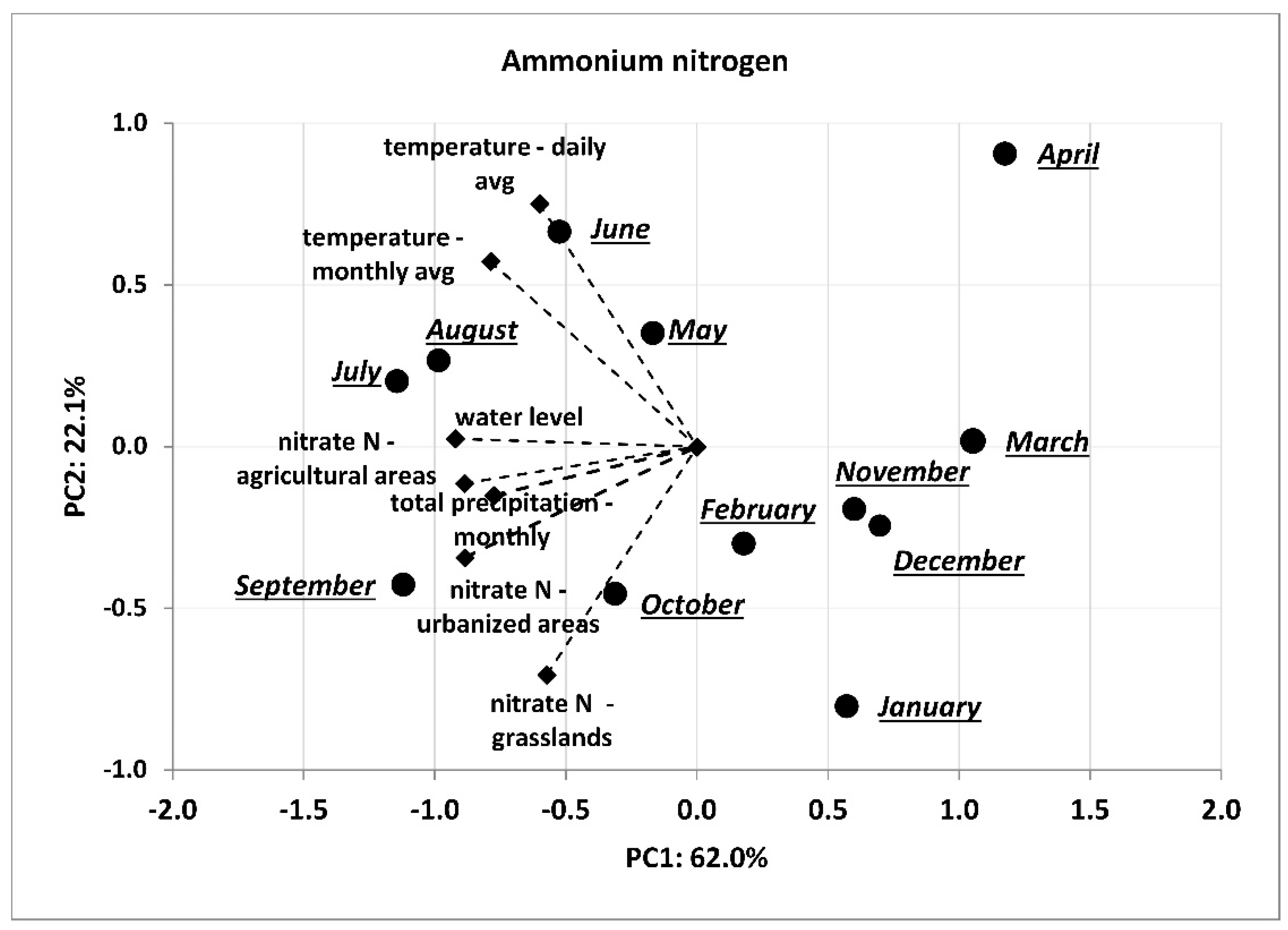
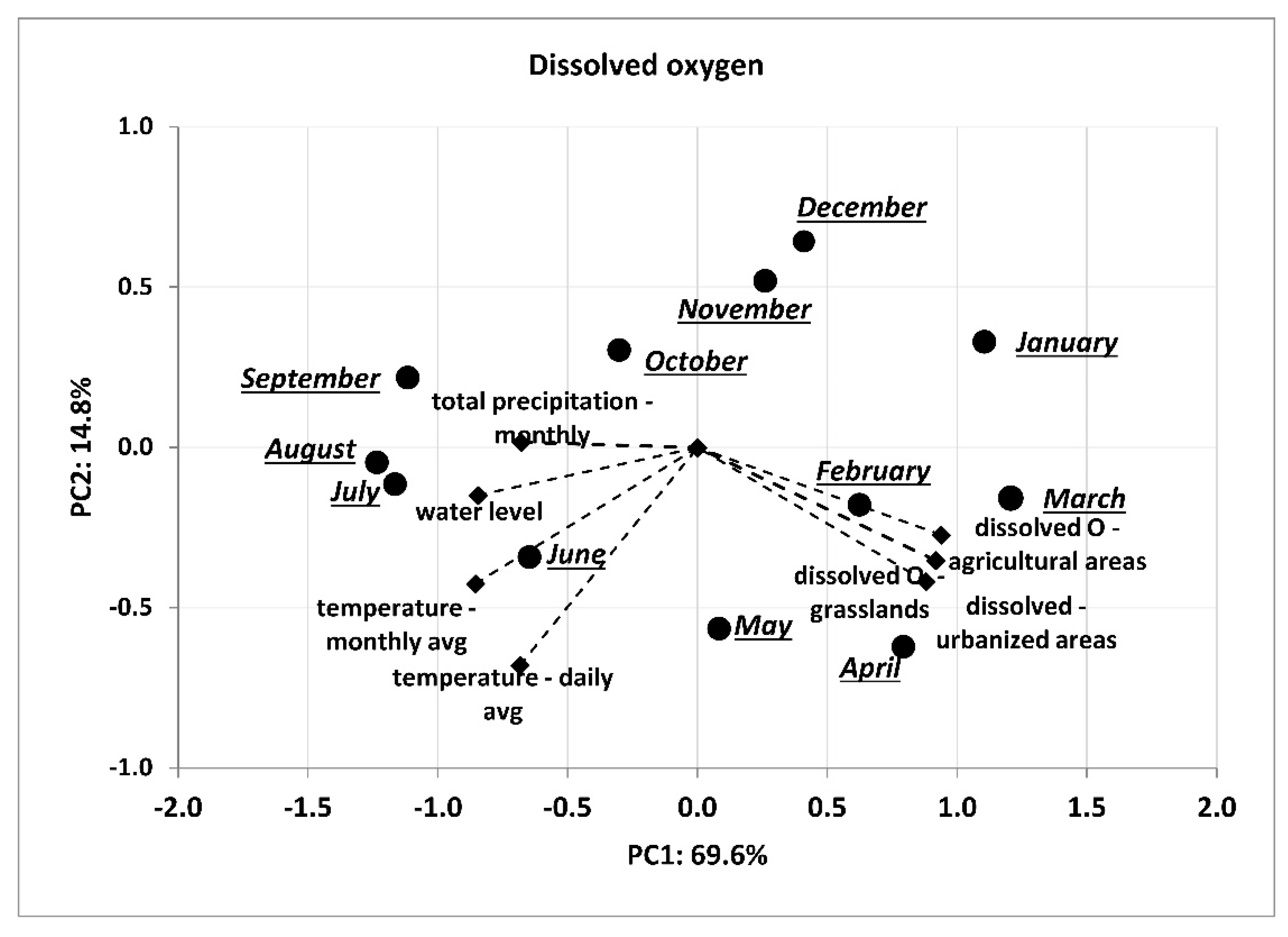
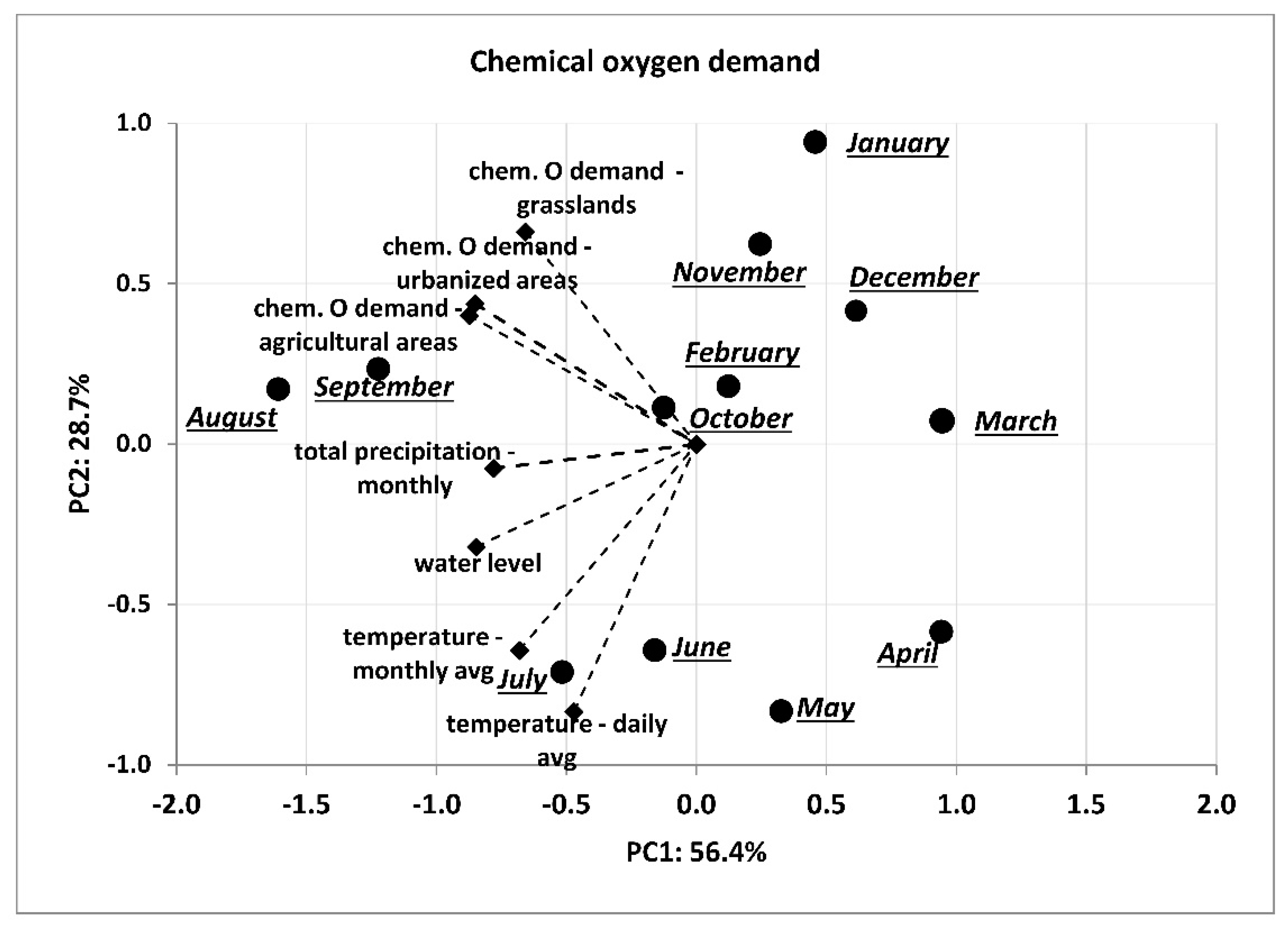
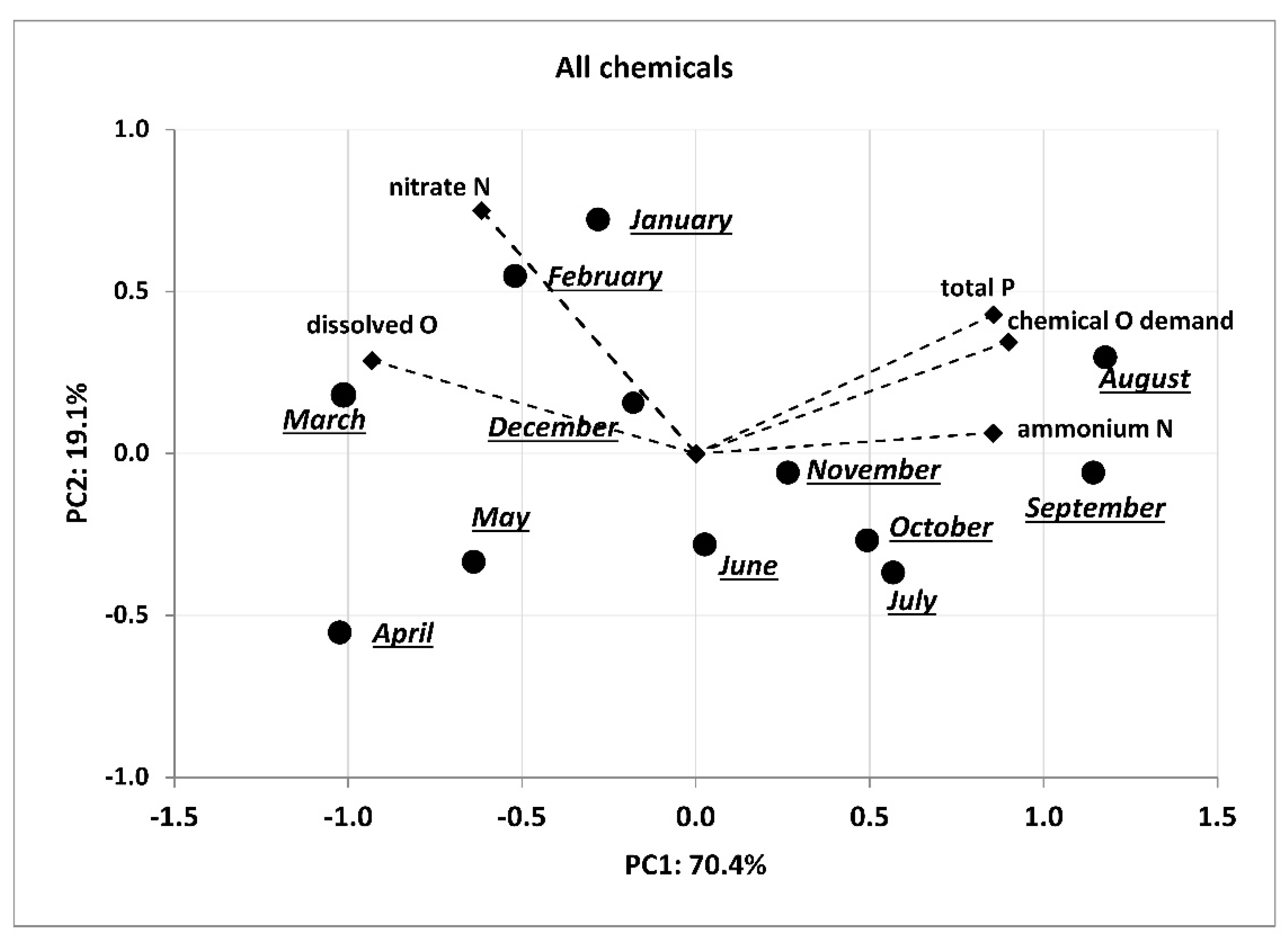
| Months | 4/2019 | 5/2019 | 6/2019 | 7/2019 | 8/2019 | 9/2019 | 10/2019 | 11/2019 | 12/2019 | 1/2020 | 2/2020 | 3/2020 |
|---|---|---|---|---|---|---|---|---|---|---|---|---|
| water level [cm] | 86 | 132 | 133 | 140 | 150 | 161 | 134 | 94 | 99 | 85 | 135 | 95 |
| temperature daily average [C] | 17.9 | 16.9 | 18.4 | 20.5 | 17.8 | 13.9 | 11 | 7.4 | 2.5 | 1 | 8 | 6.5 |
| temperature monthly average [C] | 9.8 | 13.2 | 22 | 19 | 20.1 | 14 | 10,4 | 6 | 3.1 | 2.2 | 3.9 | 4.3 |
| total precipitation—monthly average [mm] | 11.9 | 47.5 | 24.1 | 64.3 | 69.5 | 79.1 | 21.6 | 13.6 | 40.4 | 28.6 | 53.8 | 15.1 |
Publisher’s Note: MDPI stays neutral with regard to jurisdictional claims in published maps and institutional affiliations. |
© 2021 by the authors. Licensee MDPI, Basel, Switzerland. This article is an open access article distributed under the terms and conditions of the Creative Commons Attribution (CC BY) license (https://creativecommons.org/licenses/by/4.0/).
Share and Cite
Dębska, K.; Rutkowska, B.; Szulc, W.; Gozdowski, D. Changes in Selected Water Quality Parameters in the Utrata River as a Function of Catchment Area Land Use. Water 2021, 13, 2989. https://doi.org/10.3390/w13212989
Dębska K, Rutkowska B, Szulc W, Gozdowski D. Changes in Selected Water Quality Parameters in the Utrata River as a Function of Catchment Area Land Use. Water. 2021; 13(21):2989. https://doi.org/10.3390/w13212989
Chicago/Turabian StyleDębska, Katarzyna, Beata Rutkowska, Wiesław Szulc, and Dariusz Gozdowski. 2021. "Changes in Selected Water Quality Parameters in the Utrata River as a Function of Catchment Area Land Use" Water 13, no. 21: 2989. https://doi.org/10.3390/w13212989






